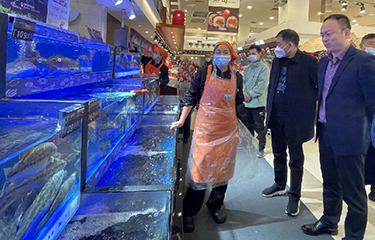At a company event at its headquarters in Chengdu, China, in June 2023, Tongwei Foods President Chen Bo announced a trebling of the conglomerate’s processed seafood sales in 2022.
Tongwei, which is a major player in solar power and which has installed panels above many of its aquaculture facilities, has been keen to improve on its profit margins and shift away from reliance on its staple, low-margin aquafeed business. Tongwei recorded a gross profit margin of 7.8 percent – a drop of 1.6 percent – in its feed and food business in 2022.
However, overall, Tongwei grew its revenue nearly 30 percent to CNY 31.6 billion (USD 4.4 billion, EUR 4.2 billion), in 2022. And it is doubling down on aquaculture, having recently commenced work on a land-based, 10,000-metric-ton, 134-hectare shrimp farm in Dongying, Shandong province, at a cost of CNY 1 billion (USD 140.1 million, EUR 126.8 million).
Among the speakers at the event was Huang Geng, vice president of the Federation of the Global Chinese Catering Industry, who said there had been an “upsurge” in orders from Chinese catering companies for semi-prepared seafood. Tongwei subsidiary Hainan Lake Foods used the Chengdu event to launch a range of chili-flavored tilapia and catfish fillets for catering companies to take advantage of the growing catering market in China.
Also at the event, Tongwei Foods introduced a range of new processed and flavored filets of catfish and tilapia. Tongwei has worked to rebrand tilapia as bream as part of a rebranding process that seeks to change consumer perceptions of tilapia.
Tongwei Vice President Xue Feng said the company planned to increase its range of new convenience and ready-meal products and predicted Tongwei will win cross-regional market share with a larger range of branded, consumer-facing products.
“They meet the demands of modern society for convenience and for food with health benefits,” Xue said.
Feng said convenience retailers and restaurant chains have expanded in recent decades alongside the urbanization of China’s population, and that China’s urbanization level now stands at 65.2 percent, bringing China on a par with some Western societies.
Also at the event, Chengdu Dachi Batang Catering Management Head Jiang Zhen Quan noted rising demand for processed and semi-processed seafood from mass-market restaurant chains. Traditionally, Chinese restaurants have served fresh fish, often kept in water tanks in the restaurant, to reassure clients of their freshness, but consumer preferences are changing across the country, Jiang said.
Tongwei isn’t the only Chinese seafood firm looking to expand its range of convenience offerings …
Photo courtesy of Tongwei








